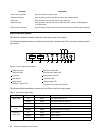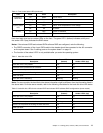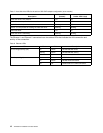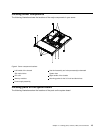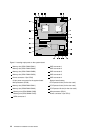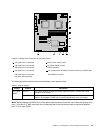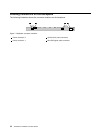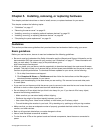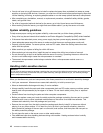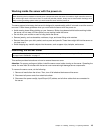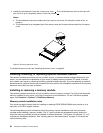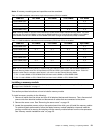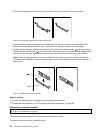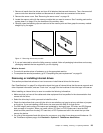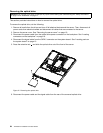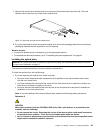
• You do not have to turn off the server to install or replace hot-swap fans, redundant hot-swap ac power
supplies, or hot-plug USB devices. However, you must turn off the server before performing any steps that
involve installing, removing, or replacing adapter cables or non-hot-swap optional devices or components.
• After completing any installation, removal, or replacement procedure, reinstall all safety shields, guards,
labels, and ground wires.
• For a list of supported optional devices for the server, go to http://www.lenovo.com/thinkserver.
• When working inside the server, you might nd some tasks easier if you lay the server on its side.
System reliability guidelines
To help ensure proper cooling and system reliability, make sure that you follow these guidelines:
• Every drive bay has an internal drive installed or an Electro Magnetic Compatibility (EMC) shield installed.
• If the server has redundant power, every power supply bay has a power supply assembly installed.
• Leave adequate space around the server to make sure that the server cooling system works well.
• Properly route the cables. For some options, such as PCI cards, follow the cabling instructions that
come with the options.
• Make sure that you replace a failing fan within 48 hours.
• When replacing a hot-swap drive, install the new hot-swap drive within two minutes of removal.
• Do not remove any air duct or air bafes while the server is running. Operating the server without the
air duct or air bafes might cause the microprocessor to overheat.
• The second microprocessor socket always contains either a microprocessor socket cover or a
microprocessor.
Handling static-sensitive devices
Attention:
Do not open the static-protective package containing the new part until the defective part has been removed from the
server and you are ready to install the new part. Static electricity, although harmless to you, can seriously damage
server components and parts.
When you handle server parts and components, take these precautions to avoid static-electricity damage:
• Limit your movement. Movement can cause static electricity to build up around you.
• Wear an electrostatic-discharge wrist strap, if one is available.
• Always carefully handle the parts and other components (such as PCI cards, memory modules, system
boards, and microprocessors) by its edges or its frame. Do not touch solder joints, pins, or exposed
circuitry.
• Prevent others from touching the parts and other computer components.
• Before you replace a new part, touch the static-protective package containing the new part to a metal
expansion-slot cover or other unpainted metal surface on the server for at least two seconds. This
reduces static electricity from the package and your body.
• Remove the new part from the static-protective package and directly install it in the server without
placing it on any other surface. If it is hard for you to do this in your specic situation, place the
static-protective package of the new part on a smooth, level surface, and then place the new part on
the static-protective package.
• Do not place the part on the server cover or other metal surface.
• Take additional care when handling devices during cold weather. Heating reduces indoor humidity
and increases static electricity.
18 ThinkServer Installation and User Guide



